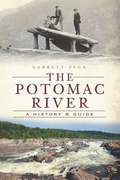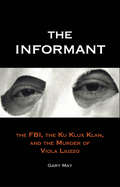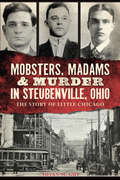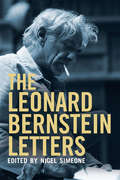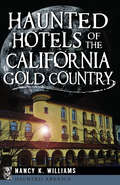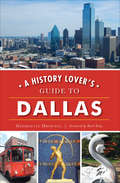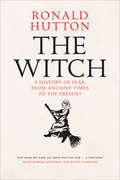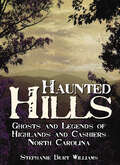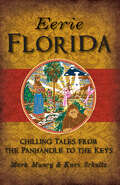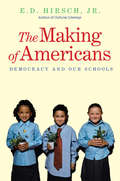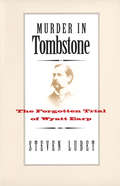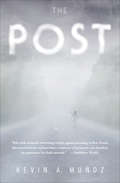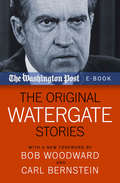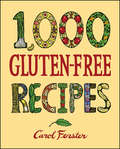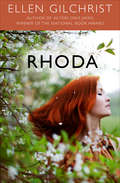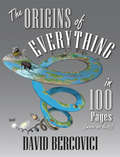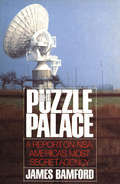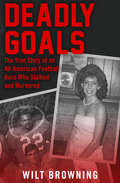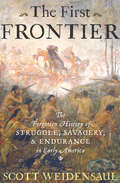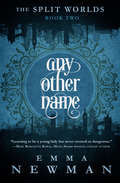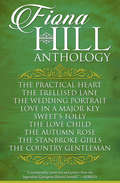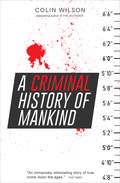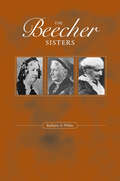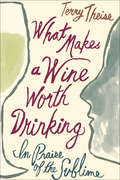- Table View
- List View
The Potomac River: A History & Guide (History And Guide Ser.)
by Garrett PeckThe story of the Potomac is the story of America—take a historic hike with this fascinating guide. The great Potomac River begins in the Alleghenies and flows 383 miles through some of America's most historic lands before emptying into the Chesapeake Bay. The course of the river drove the development of the region and the path of a young republic. Maryland's first Catholic settlers came to its banks in 1634 and George Washington helped settle the new capital on its shores. During the Civil War the river divided North and South, and it witnessed John Brown's raid on Harper's Ferry and the bloody Battle of Antietam. In this book, Garrett Peck leads readers on a journey down the Potomac, from its first fount at Fairfax Stone in West Virginia to its mouth at Point Lookout in Maryland. Combining history with recreation, Peck has written an indispensible guide to the nation's river.
The Informant: The FBI, the Klu Klux Klan, and the Murder of Viola Luzzo
by Gary MayAn FBI&’s informant&’s role in the murder of a civil rights activist by the KKK is explored in this &“suspenseful and vigorously reported&” history (Baltimore Sun). In 1965, Detroit housewife Viola Liuzzo drove to Alabama to help organize Martin Luther King&’s Voting Rights March from Selma, Alabama, to Montgomery. But after the march&’s historic success, Liuzzo was shot to death by members of the Birmingham Ku Klux Klan. The case drew national attention and was solved almost instantly, because one of the Klansman present during the shooting was Gary Thomas Rowe, an undercover FBI informant. At the time, Rowe&’s information and testimony were heralded as a triumph of law enforcement. But as Gary May reveals in this provocative book, Rowe&’s history of collaboration with both the Klan and the FBI was far more complex. Based on previously unexamined FBI and Justice Department Records, The Informant demonstrates that in their ongoing efforts to protect Rowe&’s cover, the FBI knowingly became an accessory to some of the most grotesque crimes of the Civil Rights era—including a vicious attack on the Freedom Riders and perhaps even the bombing of the Sixteenth Street Baptist Church. A tale of a renegade informant and a tragically dysfunctional intelligence system, The Informant offers a dramatic cautionary tale about what can happen when secret police power goes unchecked.
Mobsters, Madams & Murder in Steubenville, Ohio: The Story of Little Chicago (True Crime Ser.)
by Susan GuyThis true crime history chronicles more than a century in the life of a small Midwestern city with an outsized reputation for violence and vice. Gambling, prostitution and bootlegging have been going on in Steubenville for well over century. In its heyday, the city&’s Water Street red-light district drew men from hundreds of miles away, as well as underage runaways. The white slave trade was rampant, and along with all the vice crimes, murders became a weekly occurrence. This revealing history chronicles the rise of Steubenville&’s prodigious underworld from the 1890s to the modern day. By the turn of the century, Steubenville&’s law enforcement seemed to turn a blind eye, and cries of political corruption were heard in the state capital. This scenario replayed itself over and over again during the past century as mobsters and madams ruled and murders plagued the city and surrounding county at an alarming rate. Newspapers nationwide would come to nickname this mecca of murder "Little Chicago."
The Leonard Bernstein Letters
by Leonard Bernstein&“With their intellectual brilliance, humor and wonderful eye for detail, Leonard Bernstein&’s letters blow all biographies out of the water.&”—The Economist (2013 Book of the Year) Leonard Bernstein was a charismatic and versatile musician—a brilliant conductor who attained international superstar status, and a gifted composer of Broadway musicals (West Side Story), symphonies (Age of Anxiety), choral works (Chichester Psalms), film scores (On the Waterfront), and much more. Bernstein was also an enthusiastic letter writer, and this book is the first to present a wide-ranging selection of his correspondence. The letters have been selected for the insights they offer into the passions of his life—musical and personal—and the extravagant scope of his musical and extra-musical activities. Bernstein&’s letters tell much about this complex man, his collaborators, his mentors, and others close to him. His galaxy of correspondents encompassed, among others, Aaron Copland, Stephen Sondheim, Jerome Robbins, Thornton Wilder, Boris Pasternak, Bette Davis, Adolph Green, Jacqueline Kennedy Onassis, and family members including his wife Felicia and his sister Shirley. The majority of these letters have never been published before. They have been carefully chosen to demonstrate the breadth of Bernstein&’s musical interests, his constant struggle to find the time to compose, his turbulent and complex sexuality, his political activities, and his endless capacity for hard work. Beyond all this, these writings provide a glimpse of the man behind the legends: his humanity, warmth, volatility, intellectual brilliance, wonderful eye for descriptive detail, and humor. &“The correspondence from and to the remarkable conductor is full of pleasure and insights.&”—The New York Times Book Review (Editors&’ Choice) &“Exhaustive, thrilling [and] indispensable.&”—USA Today (starred review)
Haunted Hotels of the California Gold Country (Haunted America)
by Nancy K WilliamsIn this historic region of northern California, there are hotels where some guests never checked out—even after death . . . Step across the threshold of a haunted hotel in California&’s renowned Gold Country and encounter phantom figures of yesteryear. Wispy apparitions of gentleman guests in Victorian coats and ladies in fashionable flapper gowns glide through the walls, while unexplained sobs and choking gasps disturb the night. There&’s Stan, the Cary House&’s eternal desk clerk, and bachelor ghost Lyle, who tidies the Groveland Hotel. Flo tosses pots and pans in the National&’s kitchen, while the once-scorned spirit of Isabella ties the Sierra Nevada House&’s curtains in knots. From suicidal gamblers to murdered miners, the Mother Lode&’s one-time boomtowns are crowded with characters of centuries past. Book your stay with author Nancy Williams as she explores the history and haunts of the Gold Country&’s iconic hotels. Includes photos!
A History Lover's Guide to Dallas (History And Guide Ser.)
by Georgette DriscollFrom the 19th century to today, a guide through the historic Dallas, Texas, and its culture, parks, and sports. Don't let the drawl fool you—Dallas boasts a dynamic history full of explosive growth. The cityscape itself seems eager to measure up to the outsized personalities that forged the town's identity. A sixty-seven-and-a-half-foot-tall giraffe statue greets visitors to the Dallas Zoo, while guests exiting the Joule Hotel encounter the gaze of a thirty-foot eyeball. A colossal Pegasus glows above it all from its perch on top of the Magnolia Petroleum building. Subtler storylines also thread their way through the forest of glass and steel, from the jazz of Deep Ellum alleyways to the peaceful paths of the Katy Trail. Author Georgette Driscoll looks beyond the inscriptions for the events that shaped Dallas into the city it is today.
The Witch: A History of Fear, from Ancient Times to the Present
by Ronald HuttonThis &“magisterial account&” explores the fear of witchcraft across the globe from the ancient world to the notorious witch trials of early modern Europe (The Guardian, UK). The witch came to prominence—and often a painful death—in early modern Europe, yet her origins are much more geographically diverse and historically deep. In The Witch, historian Ronald Hutton sets the European witch trials in the widest and deepest possible perspective and traces the major historiographical developments of witchcraft. Hutton, a renowned expert on ancient, medieval, and modern paganism and witchcraft beliefs, combines Anglo-American and continental scholarly approaches to examine attitudes on witchcraft and the treatment of suspected witches across the world, including in Africa, the Middle East, South Asia, Australia, and the Americas, and from ancient pagan times to current interpretations. His fresh anthropological and ethnographical approach focuses on cultural inheritance and change while considering shamanism, folk religion, the range of witch trials, and how the fear of witchcraft might be eradicated. &“[A] panoptic, penetrating book.&”—Malcolm Gaskill, London Review of Books
Haunted Hills: Ghosts and Legends of Highlands and Cashiers, North Carolina (Haunted America)
by Stephanie Burt WilliamsThe author of Wicked Charlotte roots out the spirited secrets of two small towns deep in the Appalachian Mountains. When the sun slips behind the trees and shadows lengthen near dusk, the mountains and valleys of Highlands and Cashiers whisper their tales of lost loves, deals gone bad, and ghosts who walk the night. This tourist destination is rich in folklore and legend—from rumors of a magical mountain volcano to the ghost of a white owl. Learn the stories and firsthand accounts of hauntings and the hard to explain. Listen to the voices winding through the hemlocks, or is it just the wind? Includes photos!
Eerie Florida: Chilling Tales from the Panhandle to the Keys (American Legends)
by Mark Muncy Kari SchultzThe author of Freaky Florida shares a unique guide to the state&’s strangest attractions—from Florida Bigfoot to lost cemeteries, UFO sightings and more. Most people know Florida as the land of endless sunny beaches, Disney World, and NASA shuttle launches. But the state is also home to many hidden mysteries, eerie legends, and tales of bizarre creatures. In Eerie Florida, author Mark Muncy and photographer Kari Schultz provide a unique guide to these truly unique sites across the Sunshine State. The Everglades is home to the elusive Skunk Ape—also known as Florida Bigfoot—a strange bipedal creature recognized by its odor. An uncanny doll reputed to have a life of its own greets visitors in a Florida Keys museum. An ancient monster is reported to roam the rivers in the northeast corners of the state, and in South Florida, a man built Coral Castle—also known as America's Stonehenge—via mysterious means. Join Mark Muncy and Kari Schultz as they uncover the history behind the state's creepiest stories and unusual locations.
Haunts of the White City: Ghost Stories from the World's Fair, the Great Fire and Victorian Chicago (Haunted America)
by Ursula BielskiThe author of Chicago Haunts explores historical reports of ghosts, the curse of H.H. Holmes, and other dark tales from the Windy City. At the close of the nineteenth century, Chicago offered the world a glimpse of humanity's most breathtaking possibilities—and its most jaw-dropping horrors. Even as the White City emerged from the ashes of the Great Fire, serial killers like H.H. Holmes stalked the sparkling new boulevards and tragic accidents plagued the factories, slums and railroads that powered the churn of industrial innovation. In other words, amid the city&’s shining achievements, there were a lot of ghosts. Demons, mesmerists and birds of ill omen preyed on the unwary from the shadows. Ship captains spoke to the dead, while undertakers discovered reanimated corpses no longer requiring services. From posh mansions built on massacre grounds to the drowned quarries of a forest preserve, Chicago historian Ursula Bielski reveals the many hauntings and unexplained phenomena hidden within the Second City.
The Making of Americans: Democracy and Our Schools
by E. D. Hirsch Jr.From the bestselling author of Cultural Literacy, a passionate and cogent argument for reforming the way we teach our children.Why, after decades of commissions, reforms, and efforts at innovation, do our schools continue to disappoint us? In this comprehensive book, educational theorist E. D. Hirsch, Jr. masterfully analyzes how American ideas about education have veered off course, what we must do to right them, and most importantly why. He argues that the core problem with American education is that educational theorists, especially in the early grades, have for the past sixty years rejected academic content in favor of &“child-centered&” and &“how-to&” learning theories that are at odds with how children really learn. The result is failing schools and widening inequality, as only children from content-rich (usually better-off) homes can take advantage of the schools&’ educational methods.Hirsch unabashedly confronts the education establishment, arguing that a content-based curriculum is essential to addressing social and economic inequality. A nationwide, specific, grade-by-grade curriculum established in the early school grades can help fulfill one of America&’s oldest and most compelling dreams: to give all children, regardless of language, religion, or origins, the opportunity to participate as equals and become competent citizens. Hirsch not only reminds us of these inspiring ideals, he offers an ambitious and specific plan for achieving them.&“Hirsch&’s case is clear and compelling. His book ought to be read by anyone interested in the education and training of the next generation of Americans.&”—Glenn C. Altschuler, The Boston Globe&“Hirsch once again challenges the prevailing &“child-centered&” philosophy, championing a return to a &“subject-centered&” approach to learning.&”—Publishers Weekly
Murder in Tombstone: The Forgotten Trial of Wyatt Earp (The Lamar Series in Western History)
by Steven LubetThis account of the court case that followed the gunfight at the OK Corral &“will interest Wild West buffs as well as readers interested in legal history&” (Publishers Weekly). The gunfight at the OK Corral lasted less than a minute—yet it became the basis for countless stories about the Wild West. At the time of the event, however, Wyatt Earp was not universally acclaimed as a hero. Among the people who knew him best in Tombstone, Arizona, many considered him a renegade and murderer. This book tells the nearly unknown story of the prosecution of Wyatt Earp, his brothers, and Doc Holiday following the famous gunfight. To the prosecutors, the Earps and Holiday were wanton killers. According to the defense, the Earps were steadfast heroes—willing to risk their lives on the mean streets of Tombstone for the sake of order. The case against the Earps, with its dueling narratives of brutality and justification, played out themes of betrayal, revenge, and even adultery. Attorney Thomas Fitch, one of the era&’s finest advocates, ultimately managed, against considerable odds, to save Earp from the gallows. But the case could easily have ended in a conviction—and Wyatt Earp would have been hanged or imprisoned instead of celebrated as an American icon. &“This trial has everything: a family feud, famous outlaws and lawmen, politics, sex, and the most famous shootout in frontier history . . . Lubet&’s accessible and highly original book will set a standard for scholarship in a field laden with folklore.&” —Allen Barra, author of Inventing Wyatt Earp
The Post
by Kevin A. MuñozA police chief ventures outside one of the last pockets of civilization to confront a monstrous evil in this postapocalyptic crime thriller. Ten years after the world&’s oil went sour and a pandemic killed most of the population, Sam Edison is the chief of police of The Little Five, a walled-in community near Atlanta, Georgia. Now the few who survive share the world with the hollow-heads: formerly human cannibals who hunt anything living for food. When a pregnant teenager is murdered shortly after arriving at The Little Five, Chief Edison discovers that she was fleeing a life of sexual slavery. Her personal nightmare is over. But when the mayor&’s stepdaughter is abducted, the trail leads Chief Edison to the horrifying realization that the entire city of Athens is engaged in human trafficking. Now will have to save the young girl and somehow make it back home, evading monsters both human and non-human all the way.
The Original Watergate Stories
by The Washington Post&“5 Held in Plot to Bug Democrats&’ Offices&”: The legendary articles that exposed a crime, ended a presidency, and changed a nation. The Washington Post&’s seminal Watergate stories have been gathered together for the first time as an e-book, including a foreword by journalists Bob Woodward and Carl Bernstein assessing the impact of their stories decades later. "5 Held in Plot to Bug Democrats' Offices Here", said the headline at the bottom of page one in the Washington Post on Sunday, June 18, 1972. The story reported that a team of burglars had been arrested inside the offices of the Democratic National Committee in the Watergate office complex in Washington. On assignment, Carl Bernstein and Bob Woodward uncovered a widespread political scandal and cover-up at the highest levels of government, culminating with the resignation of President Richard Nixon. The Post won a Pulitzer Prize for its work, which became the subject of two bestselling books and a renowned movie, All the President's Men. This eBook is a look back at the dramatic chain of events that would convulse Washington for two years and lead to the first resignation of a U.S. president, forever changing American politics.
1,000 Gluten-Free Recipes (1,000 Recipes)
by Carol Fenster&“The encyclopedia of gluten-free recipes has now arrived! What a wonderful assortment of healthy meals that even a gluten-free novice can tackle.&”—Cynthia S. Rudert, M.D., advisor for the Celiac Disease FoundationGet enough recipes to fill 5 cookbooks in one comprehensive volume! 172 Breakfast Dishes, Muffins, and Breads 75 Sandwiches, Salads, and Soups 106 Pasta, Grain, Bean, and Vegetable Dishes 205 Main Courses 377 Cookies, Cakes, Pies, and Other Desserts And Much More!Go gluten-free with ease! For the best all-purpose gluten-free cookbook, look no further. Inside, you&’ll find delicious gluten-free versions of foods you crave—including muffins, breads, pizzas, pastas, casseroles, cookies, bars, cakes, and pies. You&’ll also discover hundreds of recipes for all-American favorites, flavorful international dishes, and sophisticated special-occasion fare. It&’s everything you need to serve satisfying gluten-free meals 365 days a year!&“This book has great recipes with a fresh healthy flair. Everyone should have this cookbook. I know mine will get tattered from use.&”—Cynthia Kupper, R.D., executive director, Gluten Intolerance Group of North America&“Carol Fenster has combined simple, naturally gluten-free recipes along with those specially created for people with celiac disease. This is a comprehensive soup-to-nuts guide that any cook will use again and again.&”—Andrea Levario, J.D., executive director, American Celiac Disease Alliance
Rhoda: A Life in Stories
by Ellen GilchristA fiction collection, including two new stories, from the award-winning author: &“Rhoda is a fully realized creation. And not one to be dismissed lightly.&”—Entertainment Weekly From Ellen Gilchrist, a National Book Award winner and &“national treasure&” (The Washington Post), this volume includes twenty-three stories starring Rhoda Manning—&“the shining manifestation of Gilchrist&’s wry, intelligent, and passionate writing&” (Kirkus Review). Follow Rhoda from age eight to age sixty, as she grows from a hot-tempered, impetuous child to a complex, confident adult. Even at a young age, Rhoda loves to get her way, boasting a unique spark that only shines brighter in an adulthood full of sex and excitement. From diet pills to multiple marriages to far-reaching travels and a writing career, Rhoda&’s relentless hunger for adventure will delight all who accompany her on her journeys. &“A winner…Rhoda is as real as anyone who has ever &‘lived&’ in a book.&”—Library Journal &“Rhoda loves to shop, swear and get her own way; she has always been a vivid and indelible character.&”—Publishers Weekly &“One of the most engaging and surprisingly lovable characters in modern fiction.&”—Robert Olen Butler
The Origins of Everything in 100 Pages (More or Less)
by David BercoviciCovering 13.8 billion years in some 100 pages, a concise, wryly intelligent history of everything, from the Big Bang to the advent of human civilization.With wonder, wit, and flair—and in record time and space—geophysicist David Bercovici explains how everything came to be everywhere, from the creation of stars and galaxies to the formation of Earth&’s atmosphere and oceans, to the origin of life and human civilization. Bercovici marries humor and legitimate scientific intrigue, rocketing readers across nearly fourteen billion years and making connections between the essential theories that give us our current understanding of topics as varied as particle physics, plate tectonics, and photosynthesis. Bercovici&’s unique literary endeavor is a treasure trove of real, compelling science and fascinating history, providing both science lovers and complete neophytes with an unforgettable introduction to the fields of cosmology, geology, genetics, climate science, human evolution, and more.&“For determined minds hoping for cogent, clever explanations for what we know of the history of the universe, Bercovici nails it.&” —Shelf Awareness &“Explaining life, the universe and everything in 100 pages may be a tall order, but physicist and volcano enthusiast Bercovici rises to the challenge. . . . Origins delivers on its promise—and (bonus!) it&’s even fun to read.&” —Discover&“Clear, concise, comprehensive, and written with verve and a sense of humor, The Origins of Everything is a delightful journey through time from the big bang to the present day.&” —Doug Macdougall, author of Frozen Earth
The Puzzle Palace: A Report on NSA, America's Most Secret Agency
by James BamfordThe first book ever written on the National Security Agency from the New York Times bestselling author of Body of Secrets and The Shadow Factory. In this groundbreaking, award-winning book, James Bamford traces the NSA&’s origins, details its inner workings, and explores its far-flung operations. He describes the city of fifty thousand people and nearly twenty buildings that is the Fort Meade headquarters of the NSA—where there are close to a dozen underground acres of computers, where a significant part of the world&’s communications are monitored, and where reports from a number of super-sophisticated satellite eavesdropping systems are analyzed. He also gives a detailed account of NSA&’s complex network of listening posts—both in the United States and throughout much of the rest of the world. When a Soviet general picks up his car telephone to call headquarters, when a New York businessman wires his branch in London, when a Chinese trade official makes an overseas call, when the British Admiralty urgently wants to know the plans and movements of Argentina&’s fleet in the South Atlantic—all of these messages become NSA targets. James Bamford&’s illuminating book reveals how NSA&’s mission of Signals Intelligence (SIGINT) has made the human espionage agent almost a romantic figure of the past. Winner Best Investigative Book of the Year Award from Investigative Reporters & Editors &“The Puzzle Palace has the feel of an artifact, the darkly revealing kind. Though published during the Reagan years, the book is coolly subversive and powerfully prescient.&”—The New Yorker &“Mr. Bamford has emerged with everything except the combination to the director&’s safe.&”—The New York Times Book Review
Deadly Goals: The True Story of an All-American Football Hero Who Stalked and Murdered (Deadly Goals Ser. #Vol. 1)
by Wilt BrowningThe story of a small town football hero whose obsession and steroid rage led to murder is revealed in &“this fine true-crime tale&” (Publishers Weekly). A star athlete with a winning smile, Pernell Jefferson had no trouble attracting women. But his charming exterior belied his brutally violent tendencies. After walking away from a football career with the Cleveland Browns, he was addicted to steroids and nearly destitute. That&’s when he set his sights on Regina Butkowski. Pernell obsessively called and showed up to her home unannounced—and he battered her when she turned her attention toward other men. When Regina disappeared, the Butkowski family knew who was responsible. But even after police discovered Regina&’s charred remains in a small Virginia town, they refused to question the man most likely linked to the brutal crime. In Deadly Goals, veteran author Wilt Browning explores the devastating details of Pernell Jefferson&’s past, the disturbing nature of his crimes, and the Butkowski family&’s pleas for justice that led to his arrest. Deadly Goals was previously published under the title Where the Wildflowers Grow.
The First Frontier: The Forgotten History of Struggle, Savagery, & Endurance in Early America
by Scott Weidensaul&“Excitement abounds in Scott Weidensaul&’s detailed history of the first clashes between European settlers and Native Americans on the East Coast.&”—Nancy Marie Brown, author of The Far Traveler: Voyages of a Viking Woman Frontier: the word carries the inevitable scent of the West. But before Custer or Lewis and Clark, before the first Conestoga wagons rumbled across the Plains, it was the East that marked the frontier—the boundary between complex Native cultures and the first colonizing Europeans. Here is the older, wilder, darker history of a time when the land between the Atlantic and the Appalachians was contested ground—when radically different societies adopted and adapted the ways of the other, while struggling for control of what all considered to be their land. The First Frontier traces two and a half centuries of history through poignant, mostly unheralded personal stories—like that of a Harvard-educated Indian caught up in seventeenth-century civil warfare, a mixed-blood interpreter trying to straddle his white and Native heritage, and a Puritan woman wielding a scalping knife whose bloody deeds still resonate uneasily today. It is the first book in years to paint a sweeping picture of the Eastern frontier, combining vivid storytelling with the latest research to bring to life modern America&’s tumultuous, uncertain beginnings. &“Exciting and revealing . . . a stirring panorama of the land and the peoples who made their mark on it from the late sixteenth to eighteenth centuries . . . This is a rich tableau that both excites and informs about the forging of early American society.&”—Booklist &“Weidensaul&’s delightful storytelling brings to life the terrors and hopes of the earliest days of America.&”—Publishers Weekly
Any Other Name: The Split Worlds - Book Two (The Split Worlds #2)
by Emma NewmanSecond in the series that &“weav[es] magic, mystery, and parallel worlds together with ease&” (Adam Christopher, author of the official Stranger Things tie-in novels).Thought-provoking, wonderfully inventive, and filled with treachery and mystery, the soaring second book in the Split Worlds Series pulls Cathy, Will, Max, and Sam deeper into the twisted world of Fae-touched society. Cathy has been reluctantly married into the Iris family and moves to Londinium, the magical Nether reflection of London, setting her on a collision course with the restrictive, high-pressure social circles that demand propriety and obedience, things the vocal and free-spirited Cathy cannot abide. Will, meanwhile, is trying to find a compromise for his new bride, but whispers in his ear are urging him towards dark deeds . . . Sam, determined to dive back into the world of Exilium to rescue innocents, crosses paths with Cathy and Max once again as Max and the gargoyle uncover more information about the mysterious Agency and the chain of events that wiped out the Bath Chapter. Sacrifices, terrible deals, and dreadful revelations mark this second installment of Emma Newman&’s wondrous Split Worlds series.Praise for the Split Worlds series&“JK Rowling meets Georgette Heyer.&”—The Guardian&“Emma Newman has built a modern fantasy world with such élan and authority her ideas of why and how the seemingly irrational world of Fairy works should be stolen by every other writer in the field.&”—Bill Willingham, Eisner Award-winning author of Fables &“Learning to be a young lady has never seemed so dangerous.&”—Mary Robinette Kowal, Hugo and Nebula Award-winning author of the Lady Astronaut series
Fiona Hill Anthology
by Fiona HillA sparkling collection of Regency romances from the popular author with &“considerably more wit and pizazz than the legendary Georgette [Heyer] herself&” (Kirkus Reviews). A true artist of Regency romance, Fiona Hill paints pictures of the past with warmth and charm, enchanting readers the world over with her beautiful, heartfelt tales. Ladies and lords, viscounts and estates, Fiona Hill weaves spellbinding stories that bring readers back in time and set them in the middle of household intrigue, of passion and peril, of complicated men and independent women. In these nine tour-de-force novels, Hill takes her readers on a journey to a bygone era, into the beating heart of Regency-era England, where trouble is always afoot—and so is new love . . .Praise for the novels of Fiona Hill&“In the battle of the sexes waged in this lively Regency romance, the contestants are overtaken by circumstances . . . The victory is detailed with wit and verve.&”—Publishers Weekly on The Country Gentleman &“[A] very un-fusty Regency frolic, this one featuring a quartet of nicely matched pairs . . . another little winner.&”—Kirkus Reviews on The Stanbroke Girls
A Criminal History of Mankind
by Colin WilsonThis &“immensely stimulating story of true crime down the ages&” tells the history of human violence, from Peking Man to the Mafia (The Times, London). This landmark work offers a completely new approach to the history and psychology of human violence. Its sweep is broad, its research meticulous and detailed. Colin Wilson explores the bloodthirsty sadism of the ancient Assyrians and the mass slaughter by the armies led by Genghis Khan, Tamerlane, Ivan the Terrible, and Vlad the Impaler. He delves into modern history, exploring the genocides practiced by Stalin and Hitler. He then takes a chilling look into the sex crimes and mass murders that have become symbols of the neuroses and intensity of modern life. With breathtaking audacity and stunning insight, Wilson puts criminality firmly in a wide, illuminating historical context. &“A work of massive energy, compulsively readable, splendidly informative . . . it establishes Wilson in a European tradition of thought that includes H. G. Wells, Sartre and Shaw.&” —Time Out London &“A tremendous resource for crime buffs as well as a challenging exposition for some of the more subtle criminological thinking of our time.&” —Kirkus Reviews
The Beecher Sisters
by Barbara A. WhiteA &“rich, varied, sensitive&” biography of three nineteenth-century women: an educator, an early feminist, and the author of Uncle Tom&’s Cabin (Publishers Weekly). Daughters of the famous evangelist Lyman Beecher, Catherine, Harriet, and Isabella could not follow their father and seven brothers into the ministry. Nonetheless, they carved out path-breaking careers for themselves. Catharine Beecher founded the Hartford Female Seminary and devoted her life to improving women&’s education. Harriet Beecher Stowe became world famous as the author of Uncle Tom&’s Cabin. And Isabella Beecher Hooker was an outspoken advocate for women&’s rights. This engrossing book is a joint biography of the sisters, whose lives spanned the full course of the nineteenth century. The life of Isabella Beecher—who has never been the subject of a biography—is examined in particular detail here, as Barbara White draws on little used sources to explore Isabella&’s political development and her interactions with her sisters and with prominent people of the time—from Susan B. Anthony and Elizabeth Cady Stanton to Mark Twain.
What Makes a Wine Worth Drinking: In Praise of the Sublime
by Terry TheiseA paean to authentic wines and a New York Times Best Wine Book of the Year from the James Beard Award-winning author of Reading Between the Wines. What makes a wine worth drinking? As celebrated wine writer Terry Theise explains in this gem of a book, answering that seemingly simple question requires us to look beyond what&’s in our glass to consider much bigger questions about beauty, harmony, soulfulness, and the values we hold dear. Most of all, Theise shows, what makes a wine worth drinking is its authenticity. When we choose small-scale, family-produced wine over the industrially produced stuff, or when we opt for subtle, companionable wines over noisy, vulgar ones, we not only experience their origins with the greatest possible clarity and detail—we also gain a new perspective on ourselves and the world we inhabit. In this way, artisanal wine is not only the key to good drinking; it is also the key to a good life. An unforgettable literary journey into the heart and soul of wine, What Makes a Wine Worth Drinking is a gift to be cherished from a writer &“whose id is directly connected to his mouth&” (Eric Asimov, The New York Times). Winner of the Louis Roederer International Wine Writers&’ Awards Chairman&’s Award A &“Best Wine Gift&” by WineSpeed &“Grown-up wine writing, full of emotion . . . and, in these dangerously cynical times, exactly what we wine enthusiasts—we human beings—need.&”—The World of Fine Wine &“Theise&’s fans, as well as those just meeting him for the first time, will revel as he leads us on an existential tour of wine.&”—Dave McIntyre, The Washington Post
